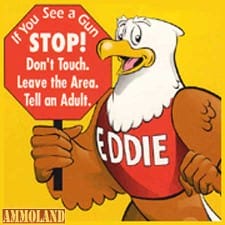
![]()
USA -(Ammoland.com)- Last week in Part 1 we discussed the hypocrisy that the anti-gun entertainment industry shows about the influence of its productions on viewers’ behavior.
It has always denied that its marketing of graphic violence affects viewers’ propensity to act violently.
Yet one of its trade associations, the Entertainment Industry Council, urges members to use anti-gun plot elements because, as it says, “entertainment. . .may influence real-life decisions and beliefs”.
Role modeling, in real and pretend life, has great influence on individuals’ future behavior, most of all during child and adolescent development. Children learn the most from observing the important adults in their lives, usually their parents (watch those driving habits!), next most (socially, at any rate) from peers and then, more formally, from schooling.
How do they learn about firearms? From film, TV and video game examples if there is no actual experience. It’s no favor to grow up believing that bullets always miss you but always hit your targets, that fingers stay on triggers at all times, and that shooting someone means either inflicting only a “flesh wound” or just wastes an immediately resurrected avatar.
In January 2014 ABC’s 20/20 televised a frequently referenced special called Young Guns. In it, 44 young children were observed in small groups in a room where real (unloaded) guns were placed among their toys. Unsurprisingly, almost all picked them up to play with, often pretending to shoot at one other or at themselves.
Host Diane Sawyer explained that “nearly all. . . had been taught ‘don’t touch a gun and tell an adult’. . .we took half of them to reinforce that message. The St. Petersburg police gave a safety class and they looked at a popular video from the NRA, ‘Eddie Eagle’. . .Then after a few days” more, the experiment took place.
Of four groups of two boys together shown, two sets would not touch the guns they found; the other two duos egged each other on to pick them up. They looked down the barrels and pointed them at each other. So there it is, proof that educating kids accomplishes nothing, and that only removing guns from their awareness can save them. . ?

Not so fast. Of fourteen girls tested, only one touched a gun. And in two of three other groups of boys, older and wiser 10-year-olds stopped their younger friends from touching them. Those younger friends were just 5 years old. Overall, 18 of 30 boys without the single days-old gun safety teaching touched them, while only 9 of 24 who’d been taught not to touch did.
In a moving plot line, two boys had never been allowed to see guns or violent media, so had no awareness of what they can do. Their mothers were terrified by their sons’ interest. A third mother had told her son about the injuries from gunfire she dealt with in the operating room. Her son touched anyway, and mostly regretted his mother knowing. Another mother (the wife of a law officer) with more insight said “For these guys, guns are about the same seriousness as crickets, frogs and cookies.”
But one child aptly questioned: “Why was the gun even in here?”. . .just before the show segued into anecdotes about children tragically, accidentally killed by guns left dangerously accessible.
In a separate article, the psychologist adviser, Marjorie Sanfilippo, avers that the study was “about the responsibilities that come with [the RKBA]. This [was] about adults’ responsibility to keep children safe.” Then, of course, adding that “the right of children to live without fear and danger supersedes a Constitutional right to bear arms.” No bias there, eh?
These details can all be viewed in the special but there’s a reason to go over them. Their cumulative effect is to make viewers fear that guns are lying around everywhere—and indeed there are easily 300 million of them somewhere in more than 1/3 of American households. Other critics have also highlighted the skewed attitude in this show-job.
Sawyer did not report that those accidents were responsible for only 124 deaths of children under 15 years old in 2013. Or that accidental deaths by drowning, burning and automobiles each vastly outnumber those from shootings in this age group. Or that for any gun accident there are specific adults responsible for their choices about how to manage firearms and children.
They certainly didn’t point out the most important things their cursory “experiment” showed.
Even the brief, and for some children unique, episode of instruction reduced the incidence of boys handling guns by nearly half, from 60% to 38%. For research interested in injury prevention, that would be the headline leading to hopeful further study.
The 5-year-olds shown were the most impulsive, but their 10 year old companions were well able to keep away. They even intervened to keep the younger ones safe. And sheltering these children from depictions of guns did nothing to protect them from their innate curiosity about the world, including firearms.
Since Young Guns, there have been more instructive demonstrations of the protective value of education. In separate reports, television stations and local police in Waterloo, Iowa and in Fairway, Kansas did similar tests earlier this year.

. . .which we’ll review, along with the right ways to raise gun-safe children, next week in Part 3.
— Robert B. Young, MD is a psychiatrist practicing in Pittsford, NY, an associate clinical professor at the University of Rochester School of Medicine, and a Distinguished Fellow of the American Psychiatric Association.
Doctors for Responsible Gun Ownership, a project of the Second Amendment Foundation. www.drgo.us
